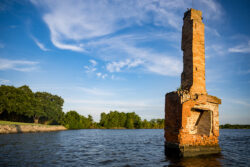Lake Peigneur Drilling Accident
An oil drilling operation at Lake Peigneur accidentally punctured a salt dome, creating a sinkhole that swallowed barges and caused the Delcambre Canal to flow backwards.

The Louisiana Endowment for the Humanities
A brick chimney and fireplace protruding from Lake Peigneur, a remnant from the destruction of the 1980 drilling accident. Paul Kieu, photographer.
A sinkhole disaster of epic proportions occurred at Lake Peigneur, just offshore from Jefferson Island in the early hours of November 20, 1980. Lake Peigneur, a small freshwater lake in south-central coastal Louisiana’s Iberia Parish, is located adjacent to Jefferson Island, the northernmost salt dome of Louisiana’s five salt domes known as the “five islands.” Although the state contains 128 listed salt domes, the five that sit along the coast tower above the surrounding flat countryside and wetlands and serve as landmarks to travelers and locals alike. On that fateful morning in 1980, a sinkhole developed in the lake as workers drilled for oil from its surface and others mined salt far below. An incorrect measurement on the part of the Texaco Oil Company resulted in a drill tip piercing the salt mine. Acting as a plug on a bathtub, the puncture created a powerful whirlpool that sucked down anything in its path. The Lake Peigneur disaster remains one of the most memorable geologic man-made disasters in national history.
Beginning in at least 1919 Jefferson Island was mined commercially for salt under then owner John Bayles. By the 1930s extensive sulfur operations developed and that mineral was profitably extracted as well. In 1956 Diamond Salt Company purchased the salt mining operations from then-owner John “Jack” Bayles Jr., whose father originally purchased the land in the 1910s as a hunting property. Jack, more interested in horticulture, developed Live Oak Gardens, an extensive garden of tropical imports and immense beauty, and later, the Live Oak Foundation.
Within the folds of the salt structure, tarry oil collects in extractable quantities. Texaco Oil Company bid on and won State Lease 124, which included the areas under Lake Peigneur, the site of the future accident. The company then subcontracted the Wilson Brothers Corporation to drill a well from a floating platform in the lake, though extensive salt mining operations occurred underneath the water. On the morning of November 20, 1980, the crew drilling near the salt mining operations reported that the tip of their drill shaft was stuck. After the crew removed the tip, they heard strange noises and abandoned the platform in the nick of time. A giant mud crater began sucking down barges, rigs, and almost some fishermen who escaped with moments to spare. A one hundred-fifty-foot waterfall developed and the Delcambre Canal, a canal draining the lake to the south, reversed course as water attempted to refill the quickly draining lake. Witnesses compared the spectacle to the eruption of Mount Saint Helens.
In the aftermath, Texaco Oil Company accused Diamond Salt Company of keeping its mining operations a secret, while Diamond insisted that Texaco and their subcontractors Wilson Brothers Corporation incorrectly triangulated the position of their drilling operation. The Live Oak Foundation sued both companies for permanently damaging Live Oak Gardens as over sixty-five acres of lakeside real estate was swallowed. In the end the foundation was awarded $12 million in damages to be paid in various increments from all responsible parties. Texaco was ordered to pay Diamond $45 million as the oil company was ultimately found at fault. Even though responsible parties were held liable, the underground salt mining operations at Jefferson Island were effectively brought to a halt. Hundreds of workers lost their jobs and were not included as part of the settlement.
